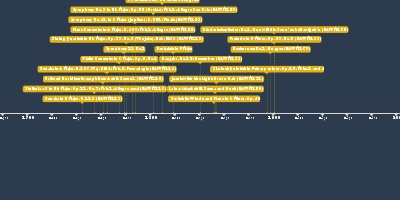jan 1, 1885 - Symphony No. 4 in E Minor, Op. 98: Mvt. 4, Allegro energico e passionato (NAWM 155)
Description:
Composer: Johannes BrahmsGenre: Symphony
This symphony was an immediate hit among audiences. In it, Brahms sought to write a masterpiece for the ages, combining elements from the nineteenth-century symphonic tradition and the more distant past in a unified vision that was distinctly his own.
Fourth movement
Exemplifies combination of influences, drawing from music spanning the previous 200 years and yet still sounding like pure Brahms through his harmonies and the links he created between movements.
Form
Chaconne: Baroque genre consisting of a series of variations over a repeating bass line in triple meter. According to a friend’s recollection, Brahms adapted the bass ostinato in this movement from the final chorus of a JS Bach cantata. The finale has 31 variations on the 8 measure theme, varying both the theme itself and the figurations that accompany it, ending with a substantial coda.
Comparison with Bach’s chaconne for solo violin from Partita No. 2 in D Minor:
-Both are in a minor key with a middle section in the parallel major
-Many variations in both are grouped in pairs
-The return to minor is signaled with a reappearance of the opening idea and texture
-Figuration: sarabande rhythm (stressing the second beat with a dotted quarter note followed by an eighth note), eighth note dotted rhythms, bariolage (violinist alternates rapidly between strings with a repeated note on one and a moving note on the other)
Comparison with Eroica:
-Both end with a set of variations (unusual for a symphonic finale)
-Bass line is first presented in the upper and middle registers, only later being placed in the bass
-Groups variations into large sections suggestions aspects of sonata-form structure without the harmonic contrasts intrinsic to the form
5 main sections
1. Variations 1-12 serve as an exposition.
2. Variations 13-16 are a transition interlude; concludes with two chorale-like variations that feature trombones and horns, an effect reminiscent of Schumann’s Third Symphony finale.
3. Variations 17-23 resemble a development section, revisiting and reworking rhythmic and melodic motives from the first several variations.
4. Recapitulation: 24-27 varies restatements of 1-4; 28-29 more distant relatives of variation 6; 30-31 introduce falling chains of thirds, direct reference to the first theme of the first movement.
5. Like Eroica, Brahms’ finale ends with a faster coda that begins with a recollection of the movement’s opening; develops the thematic material in a new way, finally freed of the theme’s recurring eight measure phrases, and builds excitement to a stirring close.
Brahms constantly varies the theme itself through figuration and registral placement, but almost everything new is an extension of something we have heard before (Schoenberg called this developing variation).
Added to timeline:
Date:
jan 1, 1885
Now
~ 140 years ago
